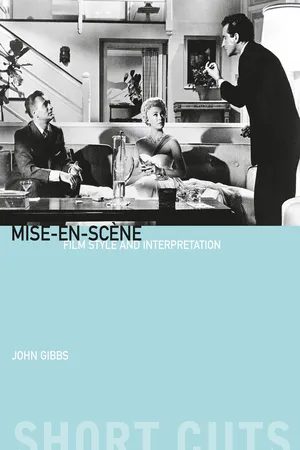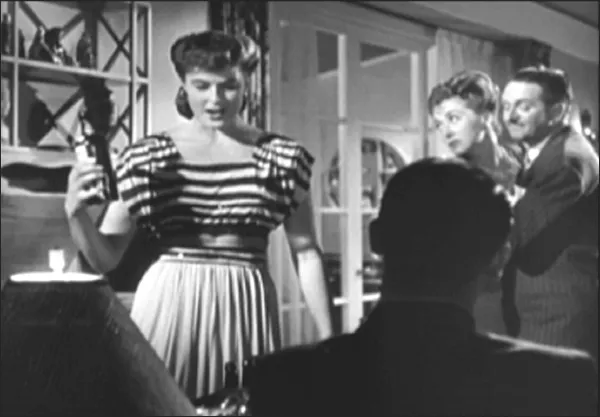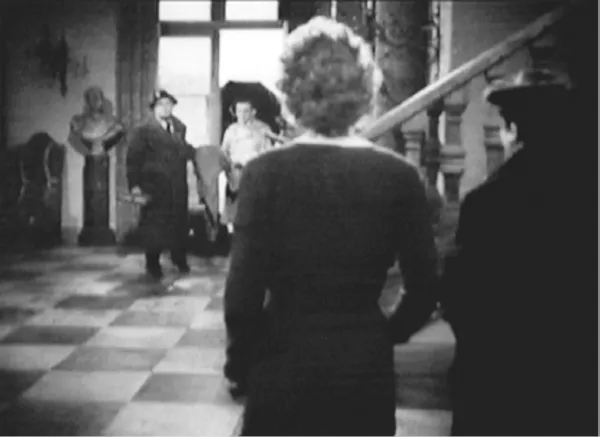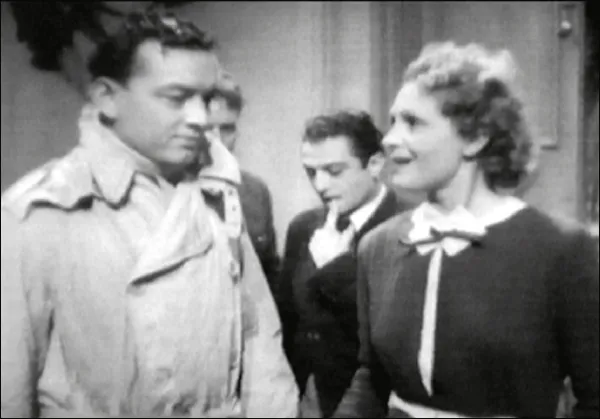
- 144 pages
- English
- ePUB (mobile friendly)
- Available on iOS & Android
eBook - ePub
About this book
Mise-en-scène: Film Style and Interpretation explores and elucidates constructions of this fundamental concept in thinking about film. In uncovering the history of mise-en-scène within film criticism, and through the detailed exploration of scenes from films as Imitation of Life and Lone Star, John Gibbs makes the case for the importance of a sensitive understanding of film style, and provides an introduction to the skills of close reading. This book thus celebrates film-making as well as film criticism that is alive to the creative possibilities of visual style.
Frequently asked questions
Yes, you can cancel anytime from the Subscription tab in your account settings on the Perlego website. Your subscription will stay active until the end of your current billing period. Learn how to cancel your subscription.
No, books cannot be downloaded as external files, such as PDFs, for use outside of Perlego. However, you can download books within the Perlego app for offline reading on mobile or tablet. Learn more here.
Perlego offers two plans: Essential and Complete
- Essential is ideal for learners and professionals who enjoy exploring a wide range of subjects. Access the Essential Library with 800,000+ trusted titles and best-sellers across business, personal growth, and the humanities. Includes unlimited reading time and Standard Read Aloud voice.
- Complete: Perfect for advanced learners and researchers needing full, unrestricted access. Unlock 1.4M+ books across hundreds of subjects, including academic and specialized titles. The Complete Plan also includes advanced features like Premium Read Aloud and Research Assistant.
We are an online textbook subscription service, where you can get access to an entire online library for less than the price of a single book per month. With over 1 million books across 1000+ topics, we’ve got you covered! Learn more here.
Look out for the read-aloud symbol on your next book to see if you can listen to it. The read-aloud tool reads text aloud for you, highlighting the text as it is being read. You can pause it, speed it up and slow it down. Learn more here.
Yes! You can use the Perlego app on both iOS or Android devices to read anytime, anywhere — even offline. Perfect for commutes or when you’re on the go.
Please note we cannot support devices running on iOS 13 and Android 7 or earlier. Learn more about using the app.
Please note we cannot support devices running on iOS 13 and Android 7 or earlier. Learn more about using the app.
Yes, you can access Mise-en-scène by John Gibbs in PDF and/or ePUB format, as well as other popular books in Media & Performing Arts & Film & Video. We have over one million books available in our catalogue for you to explore.
Information
1 THE ELEMENTS OF MISE-EN-SCÈNE
A Workable Definition
‘Mise-en-scène’ is used in film studies in the discussion of visual style. The word is from the French, although it has been employed in English since at least 1833, and has its origins in the theatre. Literally translated it means ‘to put on stage’, but figurative uses of the term have a long history. For the student of film, a useful definition might be: ‘the contents of the frame and the way that they are organised’. Both halves of this formulation are significant—the contents and their organisation.
What are the contents of the frame? They include lighting, costume, décor, properties, and the actors themselves. The organisation of the contents of the frame encompasses the relationship of the actors to one other and to the décor, but also their relationship to the camera, and thus the audience’s view. So in talking about mise-en-scène one is also talking about framing, camera movement, the particular lens employed and other photographic decisions. Mise-en-scène therefore encompasses both what the audience can see, and the way in which we are invited to see it. It refers to many of the major elements of communication in the cinema, and the combinations through which they operate expressively.
The main body of this chapter looks at some of the different elements of mise-en-scène, in order to illustrate the range of creative options available to film-makers and to introduce some of the ways in which critics have found the visual field expressive.
Lighting
When I was an undergraduate, I remember studying a shot in Notorious (Alfred Hitchcock, 1946) which makes a great deal of the expressive power of lighting: the long take which begins the second sequence of the film. Alicia Huberman (Ingrid Bergman), whose father has just been convicted of treason against the USA, is conducting a soirée. As she and her drunken guests dance or talk, they are illuminated evenly and unremarkably. However, as the scene progresses, Alicia directs her attention towards a silent guest in the foreground of the image. This man sits with his back to the camera, at the very edge of the light which falls on the others. He says nothing when Alicia accuses him of being a party-crasher, or even when she expresses her admiration for him. We know little about this figure, but we may perhaps have identified the silhouette as belonging to the film’s male lead, Cary Grant.
The organisation of light, actors and camera makes possible a series of suggestive readings. Cary Grant’s darkened silhouette makes it look as though he was sitting in the row in front of us in the cinema. We join Grant in his observation, we are behind him, we share a similar perspective. Grant is scrutinising the inebriated and incautious Bergman, as are we, but we cannot scrutinise Grant. In retrospect this can be seen as an informing image for the film: Cary Grant’s character remains an onlooker for most of the movie, and continues to view Alicia judgementally. He does not speak in this scene—later in the movie he refuses to tell Alicia that he loves her, to an almost sadistic degree. (Andrew Britton goes so far as to call Devlin, Grant’s character, ‘the most detestable leading man in the American popular cinema’ (1983: 8).) By associating our view with that of a character who turns out to be an extraordinarily unpleasant hero—and by doing so in a way that draws attention to our own status as members of an audience—the film opens the possibility of a critique of spectatorship.1

FIGURE 1 Notorious: Devlin (Cary Grant) in silhouette
Costume
George M. Wilson, the philosopher and film theorist, writes about the creative use of costume in Rebel Without a Cause (Nicholas Ray, 1955) in his book Narration in Light. Discussing the events that take place after the fatal shooting of Plato (Sal Mineo) outside the Planetarium, Wilson writes:
Jim reaches down and zips up the red jacket that he had given Plato a few moments before, and Judy replaces a shoe that had fallen from Plato’s foot. Echoing the earlier images of the temporary ‘family’ the three kids had briefly formed, these actions have the look of an attempt by the parents to bundle their children against the cold. The gesture, taken in this way, is pathetic and ironic. Jim’s father then bends down and places his jacket on Jim’s shoulders. … With the red jacket born away on Plato and with the adult jacket now worn by Jim, an exchange of ‘uniforms’ has been effected. The jacket of rebellion is gone, and, as Jim returns to Judy’s side, he wears the token of his new and more acceptable status. (1983: 187)
A further detail, not mentioned by Wilson but entirely in keeping with the sense he makes of the scene, is the physical resemblance between Judy (Natalie Wood) and Jim’s mother (Ann Doran). As Jim (James Dean) introduces Judy to his parents the two couples are framed separately but symmetrically and, if we have not noticed the similarity before, the correspondence of hairstyle and colour of dress is strikingly apparent (Judy no longer wears her distinctive green sweater, nor the red coat she wore in the film’s opening sequence). In these ways, the film suggests that Jim and Judy are being subsumed into the world of adult society and, more chillingly, being transformed into younger versions of Jim’s parents—a bleak prospect given all that has come before. Only Plato, in Wilson’s words, is ‘the truly intransigent rebel’.
Colour
Wilson’s reading of the jackets partly depends on his sense that the film is drawing one of the familiar cultural associations with the colour red, ‘its traditional association with rebellion’ (1983: 187). Colour is an important expressive element for film-makers, and is often mobilised by means of costume, which has the advantage of a direct association with a particular character. It might equally, however, be a feature of the lighting, the set decoration, or particular props. Richard Dyer has written about the use of colour in Home from the Hill (Vincente Minnelli, 1959):
The film revolves around a conflict between a man (Robert Mitchum) and his wife (Eleanor Parker). The husband’s den in the film is painted a deep, blood red all over and is furnished in a ‘masculine’ way, with leather armchairs, rifles and hunting trophies. The rest of the house is the woman’s domain—it is decorated in off-white, with chintzy patterns and in upper-class good taste; she wears pastel colours that blend in with the setting. The house is thus divided dramatically between the male and female parts, as is the family itself. The use of colour, however, goes beyond this, through the way it relates to a blood symbolism that runs through the film. He is associated with blood, with hunting, with death, whereas she is aloof from this, cold and bloodless. Their son (George Hamilton) has to choose between these two sets of values and life-styles. The blood connection goes further still, to subconscious associations of blood—and fear—with maleness and femaleness. Thus Mitchum’s room is engorged with blood, as an erect penis, whereas Parker’s domain is drained of blood as in menstruation. (1981: 1154–5).
Often elements of mise-en-scène will work, as is the case with the ‘blood symbolism’ here, in patterns developed across the length of a film.
Props
Andrew Klevan has written about such a process of patterning in Late Spring (Yasujiro Ozu, 1949), where he argues that particular household objects in the film ‘collect meanings through repeated usage, and develop associations throughout the narrative’ (2000: 146). Late Spring is a film about a young woman, Noriko (Setsuko Hara), who lives happily with her father Somiya (Chishu Ryu) but who is eventually encouraged, rather against her will, to marry and leave the home which father and daughter had shared. Klevan argues that ‘Noriko and Somiya’s particular interaction with domestic objects delineates their emotional progression’:
Noriko’s bentwood chairs, for example, are first seen in her room where Aya and Noriko sit and chat; unlike Somiya, both Aya and Noriko seem to prefer not to sit on the floor. At the start of the film, therefore, it might be claimed that the chairs carry a straightforward meaning: they represent the ‘modernity’ of the two women because they are a Western style of furniture. Any emotional resonance gained by the presence of the chairs, however, is achieved by their development within the narrative situations. On both occasions when she is followed up into her room, Noriko settles into her chair with her back towards Somiya and her aunt. The chairs are the furniture to which she flees for comfort and protection, but are also where she ends up appearing confined.
At the end of the film, after Noriko has married, the film returns to her father left alone in the house:
Now the sadness which Somiya feels can be expressed through the use of Noriko’s chairs: his sitting on one of the chairs both recalls her absence and conveys an unfamiliar position for him. Thus, a household chair, never pushed to the centre of attention, always deployed or relocated without emphasis, is able to encapsulate both Somiya’s loss and the disruption for him in these final moments. (2000: 146–7)
Décor
V.F. Perkins’ ‘Moments of Choice’, an article which should be much better known than it is (see Appendix, for details), examines the range of areas of decision-making involved in film direction, and provides a series of examples of the ways different elements of mise-en-scène (although the word is not used) can be employed expressively. As an example of décor, Perkins turns to Jean Renoir’s much admired film, La Règle du Jeu (1939):
A justly famous scene in La Règle du Jeu … gains much of its effect from Renoir’s use of decor. At the start of a country-house party, the aristocratic hostess, Christine, is obliged to confront the gossip surrounding her relationship with a young aviator, André Jurieu. She does this by introducing him to her other guests as a group with a speech in praise of pure friendship. The scene is set in the château’s entrance hall and the decor is a perfectly credible arrangement of doors, pillars and open space. But Renoir’s disposition of his actors and camera turns the space into a theatrical arena as Christine takes André ‘centre stage’ to present him to the others, grouped at a little distance to constitute the audience, while her husband and his friend look on anxiously and at last proudly from ‘the wings’. The sense of Christine’s performance as one governed by strict rules, where a wrong move threatens disaster, emerges from another parallel that the decor permits: the camera sees the floor, with Christine and André moving across its black-and-white marble tiles, as a chess-board. The power of the scene largely derives from the tension between Christine’s nervously awkward sincerity and the demand implied by the theatre/chess-game image for the precise execution of a delicate manoeuvre. (1981: 1143)

FIGURE 2 La Règle du Jeu: Christine (Nora Gregor), Octave (Jean Renoir) and André (Roland Toutain) hesitate in ‘the wings’ before making their entrance

FIGURE 3 Christine speaks to André and the other guests while her husband (Marcel Dalio) and Octave (partly obscured) ‘look on anxiously‘
Action and performance
At an important base level, mise-en-scène is concerned with the action and the significance it might have. Whilst thinking about décor, lighting and the use of colour, we should not forget how much can be expressed through the direction of action and through skillful performance. A very great deal of significance can be bound up in the way in which a line is delivered, or where an actor is looking at a particular moment. The effects that Perkins attributes to Renoir’s film are in part suggested by the performances, and would not be possible without them.
Critics have often found writing about performance and the complexities it can suggest very difficult, but this should not lead one to overlook the extent to which performance is central to our understanding of narrative film, nor the...
Table of contents
- Cover
- Half title
- Series Page
- Title
- Copyright
- Contents
- List of Illustrations
- Acknowledgments
- Introduction
- 1. The Elements of Mise-en-scène
- 2. The Interaction of Elements
- 3. Coherent Relationships
- 4. Investigations in the Critical History of Mise-en-scène
- 5. Mise-en-scène and Melodrama
- 6. Case Study: Imitation of Life
- Conclusion
- Appendix
- Notes
- Bibliography
- Index